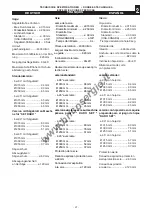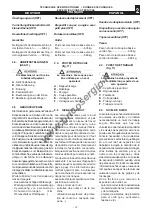
SPECIFICHE TECNICHE • SPECIFICATIONS
ENGLISH
ITALIANO
-
30
-
2.
Ruote di trasferimento
(OPT)
Dispositivo tagli angolati con
pianetto
(OPT)
Battute reversibili
(OPT)
Pesi
Peso netto macchina base
versione fissa ............... ~535 kg
Peso netto macchina base
versione inclinabile ....... ~580 kg
2.4.
POSTAZIONI
DI LAVORO (fig. 11)
La macchina è stata concepita
per essere utilizzata da un solo
operatore.
A
- Piallatura filo
B
- Piallatura spessore
C
- Foratura
D
- Taglio parallelo
E
- Lavorazioni alla toupie
F
- Lavorazioni al carro
2.5.
LIVELLO DI
RUMOROSITÀ
I valori misurati per il rumore sono
livelli di emissione e non necessa-
riamente livello di lavoro sicuro.
Mentre vi è una correlazione tra
livelli di emissione e livelli di espo-
sizione, questa non può essere
usata affidabilmente per determi-
nare se siano richieste o no ulte-
riori precauzioni. I fattori che
influenzano il reale livello di espo-
sizione del lavoratore includono la
durata dell'esposizione, le carat-
teristiche dell'ambiente, altre sor-
genti di emissione, per es. il
numero delle macchine e altre la-
vorazioni adiacenti. Anche i livelli
di esposizione permessi possono
variare da paese a paese. Queste
informazioni comunque mettono in
grado l'utilizzatore della macchina
di fare una migliore valutazione
dei pericoli e dei rischi.
Altri fattori che riducono l'esposi-
zione del rumore sono:
- corretta scelta dell'utensile
- manutenzione degli utensili e
della macchina
- utilizzo di sistemi di protezione
dell'udito (es. cuffie, tappi,...)
028.005.0.tif
A
A
F - E
D
B
C
11
Displacing wheels
(OPT)
Device for angled cuts with at-
tachment
(OPT)
Reversible Stops
(OPT)
Weights
Net weight of basic machine,
fixed version ................. ~535 kg
Net weight of basic machine,
inclinable version .......... ~580 kg
2.4.
WORKING PLACES
(fig. 11)
The machine has been
designed to be used by a
single user.
A -
Surfacing planer
B -
Thicknessing planer
C -
Drilling
D -
Parallel cutting
E -
Moulder machining
F -
Slide machining
2.5.
NOISE LEVEL
The noise levels measured are
emission levels and not necessar-
ily the safe working level. Although
there is a correlation between the
emission levels and the exposure
levels, this cannot be used reliably
to determine whether or not fur-
ther precautions are required. The
factors which affect the actual level
of operator exposure include the
duration of exposure, the ambient
characteristics and other sources
of emission, for example, the
number of machines and other
adjacent machining. The permit-
ted exposure values may also vary
from country to country. Neverthe-
less, this information allows the
user of the machine to better
evaluate the dangers and risks.
Other factors which reduce
exposure to noise are:
- correct tool choice
- tool and machine maintenance
- use of hearing protection
systems (e.g. headsets,
earplugs,...)
www.bricosergio.it
















































